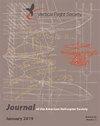A MultiDisciplinary Optimization Approach for Sizing Vertical Lift Aircraft
IF 1.4
4区 工程技术
Q2 ENGINEERING, AEROSPACE
引用次数: 2
Abstract
This paper presents an approach to reframe the sizing problem for vertical-lift unmanned aerial vehicles (UAVs) as an optimization problem and obtains a weight-optimal solution with up to two orders of magnitude of savings in wall clock time. Because sizing is performed with higher fidelity models and design variables from several disciplines, the Simultaneous Analysis aNd Design (SAND) approach from fixed-wing multidisciplinary optimization literature is adapted for the UAV sizing task. Governing equations and disciplinary design variables that are usually self-contained within disciplines (airframe tube sizes, trim variables, and trim equations) are migrated to the sizing optimizer and added as design variables and (in)equality constraints. For sizing consistency, the iterative weight convergence loop is replaced by a coupling variable and associated equality consistency constraint for the sizing optimizer. Cruise airspeed is also added as a design variable and driven by the sizing optimizer. The methodology is demonstrated for sizing a package delivery vehicle (a lift-augment quadrotor biplane tailsitter) with up to 39 design variables and 201 constraints. Gradient-based optimizations were initiated from different starting points; without blade shape design in sizing, all processes converged to the same minimum, indicating that the design space is convex for the chosen bounds, constraints, and objective function. Several optimization schemes were investigated by moving combinations of relevant disciplines (airframe sizing with finite element analysis, vehicle trim, and blade aerodynamic shape design) to the sizing optimizer. The biggest advantage of the SAND strategy is its scope for parallelization, and the inherent ability to drive the design away from regions where disciplinary analyses (e.g., trim) cannot find a solution, obviating the need for ad hoc penalty functions. Even in serial mode, the SAND optimization strategy yields results in the shortest wall clock time compared to all other approaches.垂直升力飞机尺寸的多学科优化方法
本文提出了一种将垂直升力无人机的尺寸问题重新定义为优化问题的方法,并获得了一个重量最优解,该解最多可节省两个数量级的挂钟时间。由于尺寸确定是由来自多个学科的高保真模型和设计变量执行的,固定翼多学科优化文献中的同步分析与设计(SAND)方法适用于无人机尺寸确定任务。控制方程和学科设计变量通常在学科(机身管尺寸、内饰变量和内饰方程)中是自包含的,它们被迁移到尺寸优化器中,并作为设计变量和(in)等式约束添加。为了尺寸一致性,将迭代权收敛环替换为尺寸优化器的耦合变量和相关的等式一致性约束。巡航空速也被添加为一个设计变量,并由尺寸优化器驱动。该方法演示了尺寸的包裹递送车辆(升力增强四旋翼双翼飞机尾座机)与多达39个设计变量和201个约束。基于梯度的优化从不同的起点开始;没有叶片形状设计的尺寸,所有的过程收敛到相同的最小值,表明设计空间是凸的选择边界,约束和目标函数。通过将相关学科(机身尺寸与有限元分析、车辆内饰和叶片气动形状设计)结合到尺寸优化器中,研究了几种优化方案。SAND策略的最大优点是它的并行化范围,以及将设计从专业分析(例如,修剪)无法找到解决方案的区域驱动的固有能力,从而避免了特别惩罚功能的需要。即使在串行模式下,与所有其他方法相比,SAND优化策略也能产生最短的挂钟时间。
本文章由计算机程序翻译,如有差异,请以英文原文为准。
求助全文
约1分钟内获得全文
求助全文
来源期刊

Journal of the American Helicopter Society
工程技术-工程:宇航
CiteScore
4.10
自引率
33.30%
发文量
36
审稿时长
>12 weeks
期刊介绍:
The Journal of the American Helicopter Society is a peer-reviewed technical journal published quarterly (January, April, July and October) by AHS — The Vertical Flight Society. It is the world''s only scientific journal dedicated to vertical flight technology and is available in print and online.
The Journal publishes original technical papers dealing with theory and practice of vertical flight. The Journal seeks to foster the exchange of significant new ideas and information about helicopters and V/STOL aircraft. The scope of the Journal covers the full range of research, analysis, design, manufacturing, test, operations, and support. A constantly growing list of specialty areas is included within that scope. These range from the classical specialties like aerodynamic, dynamics and structures to more recent priorities such as acoustics, materials and signature reduction and to operational issues such as design criteria, safety and reliability. (Note: semi- and nontechnical articles of more general interest reporting current events or experiences should be sent to the VFS magazine
 求助内容:
求助内容: 应助结果提醒方式:
应助结果提醒方式:


